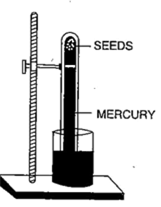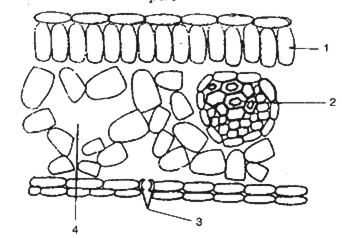 Short Answer Type
Short Answer TypeGive the appropriate terms for the following:
(i) The arrangement of xylem tissue in a vascular bundle such that the protoxylem is at the centre and the metaxylem is towards the periphery.
(ii) The region of distinct vision in the eye.
(iii) The surgical method of sterilisation in the human female.
(iv) The carbohydrate molecule found in the cell wall.
(v) The process by which cells engulf pathogens.Given alongside is the diagram of a part of the nephron pf the Kidney. Study the same and answer the questions that follow :
(i) Name the parts labeled 1, 2 and 3.
(ii) What is the collective term used for 2 and 3?
(iii) Why is the right kidney at a slightly lower level than the left?
(iv) Explain the term homeostasis. What is the role of the kidney in this?
Given below are groups of terms. In each group the first pair indicates the type of relationship that exists between the terms. Rewrite and complete the second pair on a similar basis. An example is done for you.
Example : Lung : Respiration—Kidney :'Excretion.
(i) Uterus : Implantation—Fallopian tube :
(ii) Eye : Optic nerve—Ear :
(iii) Trachea : Ciliated epithelium—Sclerenchyma :
(iv) RNA : Ribosome—Cristae :
(v) Ureter: Carrying urine—Eustachian tube :
(i) Draw the microscopic view of an onion peel and label the three basic parts of the cell in it.
(ii) How is the above-mentioned cell structurally different from the cheek cell?
(iii) Why is iodine used when preparing an onion slide?
 Long Answer Type
Long Answer TypeGiven below is a schematic representation of the circulatory system in man. Study the same and answer the questions that follow:
(i) Label the parts 1 to 4 indicated in the diagram.
(ii) Give one difference between Lungs the parts 1 and 2 based on:
(1) their structure
(2) the nature of blood flowing through them.
(iii) What is the specific name of the type of blood circulation that takes place between the heart and the lungs ?
(iv) Name the valve found at the beginning of the part labelled 3.
Differentiate between the following pairs on the basis of what is given in brackets
(i) Choroid and Sclerotic layers of the eye (Function)
(ii) Lymphocytes and Neutrophils (Structure of the nucleus)
(iii) Dynamic Balance and Static Balance (Definition)
(iv) Beginning of the ventricular systole and the ventricular diastole (Type of heart sound)
(v) Plasma and Serum (Composition)
Given below is an experimental set up to demonstrate a particular process using germinating seeds. Study the same and answer the questions that follow :
(i) Name the process being studied.
(ii) What will be observed in the set up after two to three days ? Give a reason for your answer.
(iii) Name the gas evolved during the above process. How will you test this gas?
(iv) Represent the above process in the form of a well-balanced chemical equation.Define the following terms
(i) Hypotonic solution
(ii) Non -biodegradable
(iii) Antitoxin
(iv) Asphyxiation
(v) Diapedesis.The diagram given below shows the internal structure of the lamina and midrib of a leaf Study the same and answer the questions that follow:

(i) Is the above section that of an isobilateral or dorsiventral leaf ? Give reason to support your answer.
(ii) Name the parts 1, 2, 3 and 4 indicated by the guidelines.
(iii) What is the function of the part labelled 3?
(iv) Explain how part 3 performs the function mentioned by you.(i) A dorsiventral leaf. This is so because stoma is present only on the ventral surface of the leaf.
(ii)
1 - Palisade mesophyll
2 - Xylem vessel / xylem
3 - Guard cells
4 - Substomatal airspace
(iii) Guard cells regulate the opening and closing mechanism of the stomata.
(iv) During daytime, the guard cells perform photosynthesis thus the turgor pressure increases owing to the glucose manufactured during the process. Water is drawn in from the adjoining cells due to endosmosis, resulting in the opening of the stomata. During nighttime or low-sunshine periods, the glucose manufactured is transformed into starch and transported to various other parts of the plant. Thus, water is drawn out of the guard cells due to exosmosis, resulting in the closing of the stomata.
Answer the following briefly .-
(i) Mention two functions of the World Health Organization.
(ii) Explain the following terms :
(1) Immunity
(2) Acid rain.
(iii) Define the term Antibiotic. Give an example of an antibiotic.